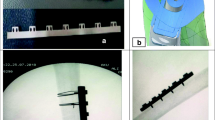Abstract
Background
The dynamic hip screw (DHS) has been widely adopted as the implant of choice in the treatment of intertrochanteric fractures. There have been attempts over the years to improve on the DHS lag screw design in order to reduce failure in the form of “cut out”. The purpose of this study was to investigate how two new design variations of the DHS, the DHS blade and the X-BOLT, behave within bone, and if these design modifications do indeed improve the fixation achieved and lead to a reduction in failure due to cut out.
Methods
“Pushout” tests were chosen as the means of investigating the failure modes and patterns for these implants that lead to cut out. These pushout studies were performed in artificial bone substrate in the form of polyurethane foam blocks and in cadaveric femoral heads.
Results
The results demonstrated that each individual implant produces its own specific distinct force–displacement curve or pattern of failure, and that despite the very different implant designs and methods of fixation, all of the implants tested reached very similar peak forces in each of the test materials used.
Conclusion
The results demonstrated that implant design only influences the pattern of failure, and that the peak forces reached by each implant are determined by the quality of the bone or test material into which they are placed. However, altering the force–displacement curve or pattern of failure may be enough to improve the fixation achieved and to provide an increased resistance to cut out.




Similar content being viewed by others
References
Baumgaertner MR, Curtin SL, Lindskog DM, Keggi JM. The value of the tip apex distance in predicting failure of fixation of peritrochanteric fractures of the hip. J Bone Joint Surg Am. 1995;77:1058–64.
Koval KJ, Zuckerman JD. Hip fractures: a practical guide to management. Berlin: Springer; 1999.
Davis TRC, Sher JL, Horsman A, Simpson M, Porter BB, Checketts RG. Intertrochanteric femoral fractures. J Bone Joint Surg Br. 1990;72-B(1):26–31.
James ETR, Hunter GA. The treatment of intertrochanteric fractures—a review article. Injury. 1983;14(5):421–31.
Schipper IB, Marti RK, Van der Werken C. Unstable trochanteric femoral fractures: extramedullary or intramedullary fixation—review of literature. Injury. 2004;35(2):142–51.
Chirodian N, Arch B, Parker MJ. Sliding hip screw fixation of trochanteric hip fractures: outcome of 1024 procedures. Injury. 2005;36(6):793–800.
Lustenberger A, Bekic J, Ganz R. Rotational instability of trochanteric fractures fixed with the dynamic hip screw. A radiological analysis. Unfallchirurg. 1995;98(10):514–7. German (PMID:7502084).
Gibson D, Keogh C, Morris S. A biomechanical study comparing the dynamic hip screw with an X-Bolt in an unstable intertrochanteric fracture model of the proximal femur. Presented at: BOA/IOA Combined Meeting; 2011 Sept 14; Dublin, Ireland.
Richards RH, Evans G, Egan J, Shearer JR. The AO dynamic hip screw and the Pugh sliding nail in femoral head fixation. J Bone Joint Surg Br. 1990;72(5):794–6.
Rosenblum SF, Zuckerman JD, Kummer FJ, Tam BS. A biomechanical evaluation of the Gamma nail. J Bone Joint Surg Br. 1992;74(3):352–7.
Aminian A, Gao F, Fedoriw WW, Zhang LQ, Kalainov DM, Merk BR. Vertically oriented femoral neck fractures: mechanical analysis of four fixation techniques. J Orthop Trauma. 2007;21(8):544–8.
Patel PSD, Shepherd DET, Hukins DWL. Compressive properties of commercially available polyurethane foams as mechanical models for osteoporotic human cancellous bone. BMC Musculoskelet Disord. 2008;9:137.
Koval KJ, Zuckerman JD. Chapter 2. In: Hip fractures: a practical guide to management. Berlin: Springer; 1999.
Acknowledgments
None. This was a self-funded research project with no external assistance.
Conflict of interest
None.
Author information
Authors and Affiliations
Corresponding author
Rights and permissions
About this article
Cite this article
O’Neill, F., McGloughlin, T., Lenehan, B. et al. Influence of implant design on the method of failure for three implants designed for use in the treatment of intertrochanteric fractures: the dynamic hip screw (DHS), DHS blade and X-BOLT. Eur J Trauma Emerg Surg 39, 249–255 (2013). https://doi.org/10.1007/s00068-013-0257-7
Received:
Accepted:
Published:
Issue Date:
DOI: https://doi.org/10.1007/s00068-013-0257-7




